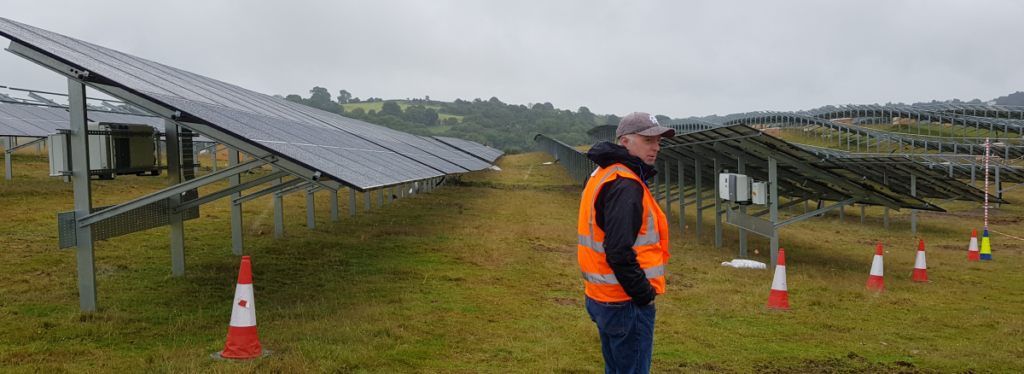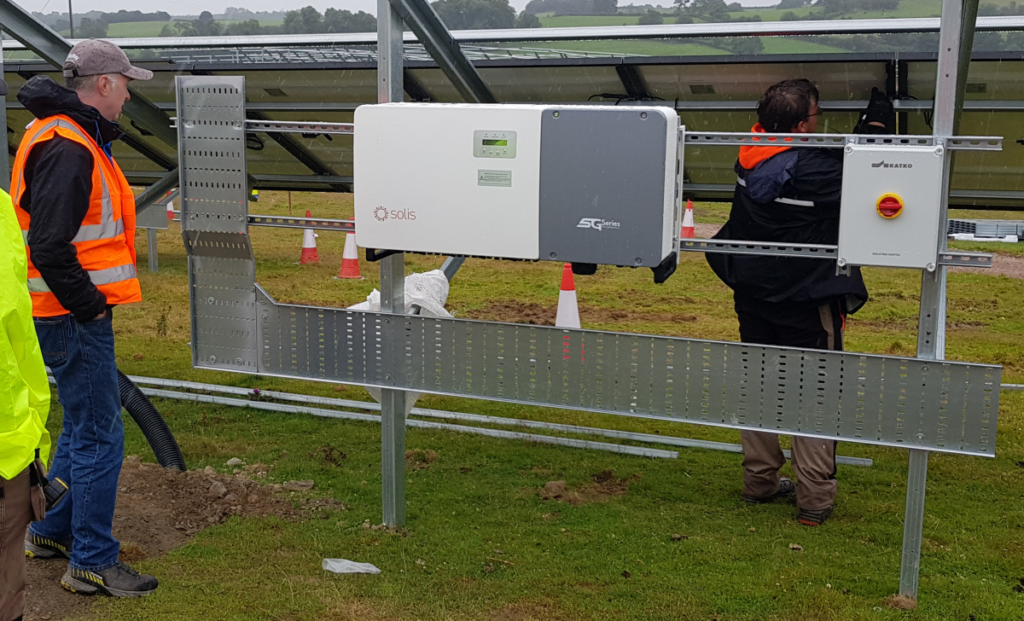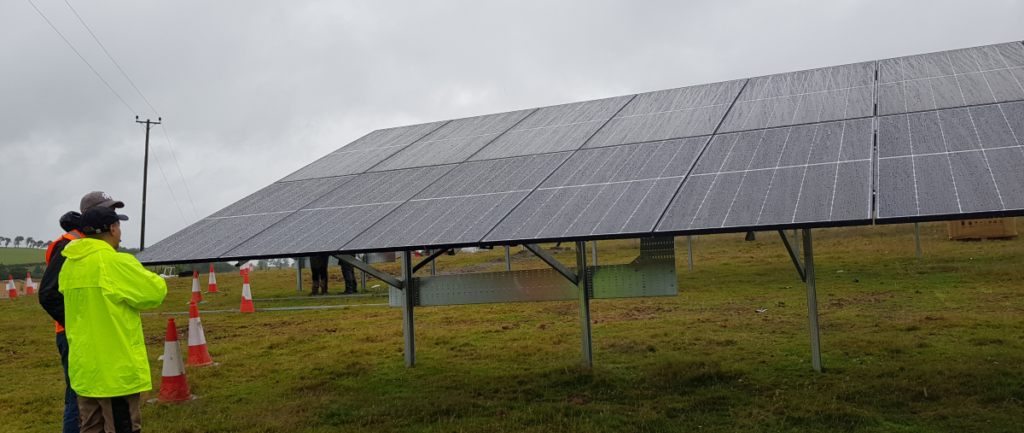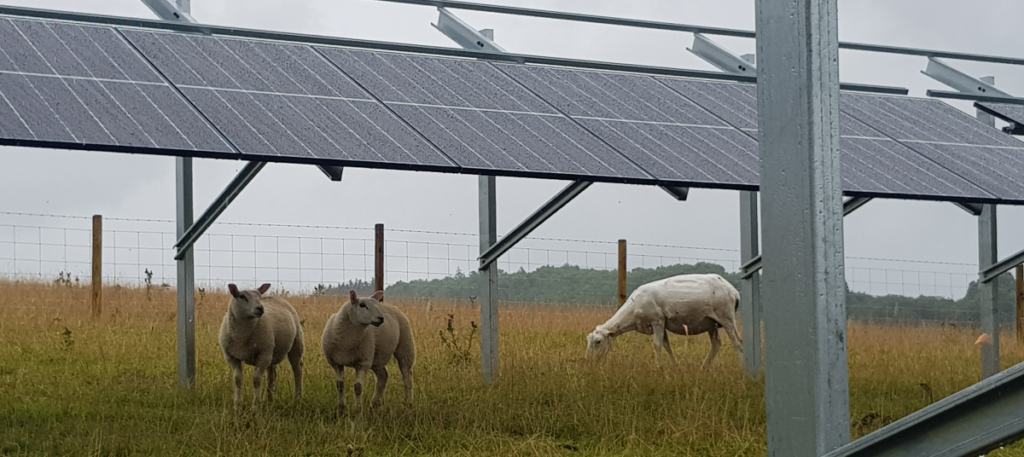In case you didn’t know. I run a small energy company and am building a small solar farm with the money I made from selling video games. Here is the company website: http://www.positechenergy.com
We made another trip to the site yesterday. Its a 350 mile round trip, and part of it was in the rain. This was the first time we visited in bad weather, but to be honest it wasn’t TOO bad. The site is basically the crest of a hill, so drainage is excellent, and it wasn’t too muddy. Despite, this they were still transporting solar panels on pallets using tracked vehicles, because…mud is still a thing.

I bought these solar panels about 8 months ago, in a fit of enthusiasm to push the project forwards. This turned out to be madness, as I then had to store 3,000 of them in a warehouse at huge expense. The panel prices did then rise…but then fell. I think overall, it was a bad decision, but not catastrophic. Despite owning solar panels all this time, I had never seen them until today. Also, 60 tons of solar panels sounds a lot, but does it look a lot in person…?

The answer is YES. It does. Its a lot of boxes, and thats not all of them, a lot of them were already fitted to the frames. Its multiple big articulated lorries full of them. On the plus side, I am no longer getting monthly storage bills. On the negative side, I had to pay £700 to the warehouse to load them on to the truck. This sounded a lot, but it is a lot of panels so… I guess its understandable.
The real excitement for this trip was to see panels actually on frames, to get an idea of what the finished project will look like. Our first impressions were that they were being fitted pretty quickly, and that the frames are really high. No danger of long grass obscuring the bottom of a panel! (A disaster when that happens, as it effectively shadows the whole panel, and indeed the whole string).

I posted that picture to give some idea of scale. Thats not a complete row of panels, we currently have a ‘gap’ awaiting the moving of the HV cable. once that is moved we can fill it in and have longer rows. You can just about see that a few rows are now double paneled, and some they have just done the bottom row. The bottom row is first, then they go back with a sort of frame to stand on so they can access the top row and fit those. There was a team of 4 people working together to mark out the location, attach the fixtures, and then place the panels on the rails. While they do this, fresh panels are delivered to points along each row on pallets ready to be fitted.
At this point, the panels are attached, but there is no wiring. A separate team of people (electricians this time) are connecting the panels together to form strings which eventually get wired to the inverters at the end of some rows.

Thats one of the inverters already mounted. Its a 100kw inverter, so about 25x the power of the kind you have if you get panels on your house. The box to the right is the emergency cut out switch. All that metal stuff underneath is just a bracket to attach a LOT of DC cabling to the inverter, which will run at head height along the length of the panels. In cases where the inverter is connected to panels on another row, there is underground armored cable & ducting to bring all the DC cabling together. Further underground ducts will connect each inverter to the substation using AC cable, but that work has not started yet. The substation design is holding everything up!

A picture to show the scale of each solar table next to a mere human. As someone with a small ground-mount array of 10 panels in his garden, its surprising how high up these are, and how tall they are at the top of the final panel. They are fitted in 2 rows height, in portrait mode (some farms are landscape), and each panel is ‘split’ into two, hence the white line in the middle. They are effectively 2 panels each, and have 2 connectors on the back of each one. Each panel outputs 410 watts
and lastly…

When people repeat stupid oil-company propaganda nonsense about losing farming land to solar panels, I’ll be tempted to reply with this. The grass is still very appealing to the sheep, and plenty of room between and under the panels for them to graze. Frankly on a day like yesterday the sheep probably thought the shelter was awesome. Technically the sheep are supposed to be out of the way during construction, mostly for their safety, but they got in somehow, and it turns out getting them out again isn’t easy. They seem to co-exist with the construction site pretty happily :D.
There will likely be a delay of a few weeks before I go back, unless something exciting happens. There are a lot of panels to attach, and then a LOT of wiring to be done, which is still a manual procedure. There is no clever automation or robotics that can do this yet. Actual humans have to walk to each panel, grab a cable, plug it in, then probably cable tie the cabling nicely out of the way, so it stays there in thunderstorms for 25 years. Maybe one day Teslabots will do this, but not this year.
The real hold up on this project has been the grid connection. First it was planning, then grid connection. I could write a whole epic space opera about how much grief it has been. I HOPE that we are now zeroing in on final agreement as to how everything will work, and thus we can a) start building the earthing mesh and connections for the substation and b) get a date for the DNO to move that overhead cable so we can fill-in the final mounting frames and tables and have everything connected.
The project is still a cause of daily worry and stress, because it involves literally dozens of people talking to each other in email threads that are contradictory, out of synch and confusing. Hopefully things get much better soon.
Meanwhile, a reminder of how important it is that we do projects like this.